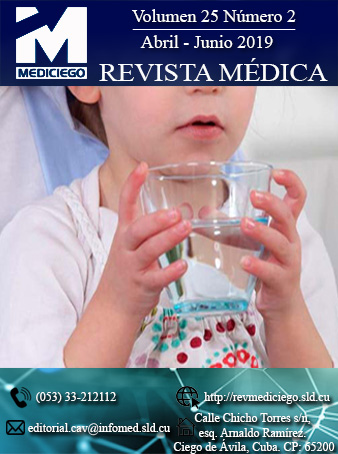Application times of the clinical dehydration and Gorelick scales in the pediatric emergency
Abstract
Introduction: dehydration is one of the most frequent clinical diagnoses in the pediatric patient. Objective: to evaluate the application times of the clinical dehydration and Gorelick scales in the pediatric emergency. Method: a cross-sectional and correlational study was carried out in 48 children between one and four years of age with diagnosed dehydration in the guardhouse of the Polyclinic "Luis Enrique de la Paz", of Yara (Granma) in the period from May to November 2016. Measures of central tendency and dispersion were applied, as well as the Pearson correlation coefficient and the T test. Results: 54,17 % belonged to the male sex with a general average age of 2,45 years, 77,08 % were diagnosed with moderate or severe dehydration according to the Gorelick scale and 33,33 % according to the clinical dehydration scale. The difference in the average time of application of both scales was 18,29 seconds, in favor of the clinical dehydration scale. This difference was statistically significant. Both scales presented a considerable positive correlation, so they are recommended for clinical practice. Conclusions: both scales have a similar diagnostic capacity; the average application time was significantly shorter for the clinical dehydration scale. The latter is more useful for discriminating the presence of mild dehydration in the first level of care, while the Gorelick scale is more advantageous for diagnosing severe dehydration, and therefore, is more appropriate for application in pediatric emergency casesDownloads
Published
How to Cite
Issue
Section
License
Copyright (c) 2021 Pedro Rafael Casado Méndez, Rafael Salvador Santos Fonseca, Gertrudis Valentina Enamorado Piña, Irina López Sánchez, Irene Luisa Del Castillo Remón

This work is licensed under a Creative Commons Attribution-NonCommercial 4.0 International License.
Those authors who have publications with this journal accept the following terms of the License CC Attribution-NonCommercial 4.0 International (CC BY-NC 4.0):
You are free to:
- Share — copy and redistribute the material in any medium or format for any purpose, even commercially.
- Adapt — remix, transform, and build upon the material for any purpose, even commercially.
The licensor cannot revoke these freedoms as long as you follow the license terms.
Under the following terms:
- Attribution — You must give appropriate credit , provide a link to the license, and indicate if changes were made . You may do so in any reasonable manner, but not in any way that suggests the licensor endorses you or your use
- No additional restrictions — You may not apply legal terms or technological measures that legally restrict others from doing anything the license permits.
The journal is not responsible for the opinions and concepts expressed in the works, which are the exclusive responsibility of the authors. The Editor, with the assistance of the Editorial Committee, reserves the right to suggest or request advisable or necessary modifications. Original scientific works are accepted for publication, as are the results of research of interest that have not been published or sent to another journal for the same purpose.
The mention of trademarks of specific equipment, instruments or materials is for identification purposes, and there is no promotional commitment in relation to them, neither by the authors nor by the editor.






















